Studio Diary: August 31, 2023
All roads lead to the Rhodes
This edition of “Studio Diary” focuses on the process I used to record an improvised jam session with my Mark 1 Rhodes Stage Piano and a variety of samplers. I also spend a bit of time explaining my history with the Rhodes piano, and how I came to love it so much.
I hesitated to post this video at all. I always have a hard time listening back to any of my music, but on this recording especially, all I could hear were things I disliked - stuff I’d do differently, mistakes with the mixing…the usual symptoms of self doubt. In the end, I had to remind myself that the whole idea of this blog is to be transparent about what I do, warts and all, and simply offer my works in progress “as is.”
I also think that this is a particularly good video to share because it’s probably the most realistic look at what actually happens when I’m setting up recording equipment and testing things out when I’m preparing to start a new project. It’s not uncommon for me to have hours of jams like this that go entirely unrecorded while I’m searching for the first idea that sparks the rest of the album.
With that said, here’s the video in full, for reference:
My history with the Rhodes
I want to spend some time detailing my personal history with the instrument at the center of this video, a 1977 Mark 1 Rhodes piano. It’s one of my most prized possessions, musical or not, and one of the few “real” instruments I still have in my studio. Readers of this blog who have seen previous posts of mine will already know (and are probably tired of hearing me say) that I don’t like the idea of holding on to too many objects, and I generally prefer to use software instruments for simplicity’s sake and to save space in my small studio room. One of the physical exceptions to the digital rule is this Rhodes.
My love affair with the Rhodes started somewhere around the 7th or 8th grade, when I was diving deep into bass guitar. At the time, I was devouring music at an unbelievable rate and challenging myself to learn how to play anything I could hear. My friend Matt had given me a cracked copy of “the amazing slow downer,” which was software that could timestretch MP3s, so I could transcribe bass parts by ear (a big deal back then, especially for people like me who had grown accustomed to rewinding the CD player and learning parts at full speed). Honestly, I wish I still had the time and patience to practice like that today. I’ve regressed pretty significantly in theory, dexterity, and sight-reading ability since then.
At some point during this relentless consumption and self-education, I heard a recording of “Break on Through” by the Doors for the first time. This was an instant “wow” moment for me. I didn’t really love the band that much outside of this particular song and a few of their other tunes (“Riders on the Storm,” anyone?), but I was immediately in love with the growly, snarling tone of this recorded bass line - I couldn’t replicate it with my own gear. Further investigation taught me about Ray Manzarek’s extensive use of the Rhodes Piano Bass, and eventually I connected the dots to other Rhodes use cases in recordings that I loved:
Led Zeppelin (No Quarter),
Ray Charles (Stormy Monday),
Herbie Hancock (Actual Proof),
…and plenty of other “classic” artists I was listening to at the time. Since then, I’ve always had an affinity for the flexibility of electric piano and its chameleon nature. It never felt out of place on any of these records, and capably fits in with so many genres of music. From a purely aesthetic perspective, I also liked that it seemed to be an instrument of choice for “edgier” bands (in their era, at least) and forward-thinking musicians. As a kid learning bass guitar, I loved that it blended into these scenes with electric guitars and amps. There was a different vibe to not just the sound, but the kinds of people using it (and the music they made) compared to the traditional piano.
(tangential rant / side note: this part about “aesthetics” is partly why I think the $10,000 USD minimum price tag of the premium new MK8 models, just introduced in the last couple of years since the change of ownership in the Rhodes brand, is so disappointing…it seems antithetical to the spirit of the Rhodes as a tough, efficient gigging instrument you’d drag into a rock club and bang up on tour, and turns it into a bit of trophy piece instead.
You can easily buy at least **5** used Mark 1 Rhodes pianos on Reverb here in the USA for the price of 1 new MK8 model!
It is a beautiful product and I’m sure it will last a long time if you have the pile of cash to grab it, but the inaccessibility of owning it now is a huge bummer for the legacy of the brand, in my opinion. I digress.)
The years went by and this instrument kept showing up in all the music I loved:
A band that changed my life in ways too significant to describe, Mutemath, had a Rhodes piano quite literally at the center of their recorded albums and live performances.
One of my first introductions to post-rock was This Will Destroy You, and although the lineup has changed and their actual status as a band has gotten murkier throughout the years, they’ve always featured the Rhodes (the real deal or VSTs) in their music.
The list goes on and on.



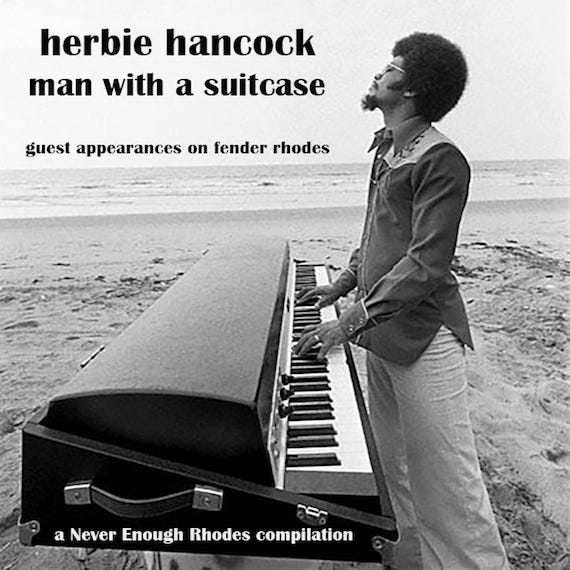
So, you can imagine the sheer joy I felt when I finally had an opportunity to get one for myself in 2017.
My uncle, himself a talented musician, retired and let go of most equipment in his home studio. I was the lucky recipient of his pristine Mark 1 Rhodes (all 88 keys and 150 pounds of it), and I’m still pinching myself to this day. It’s a 1977 model, which places it firmly in the Mark 1 Rhodes era (roughly 1975-1979). By the way…There’s a fantastic history of the evolution of each of the model years on the Rhodes “Super Site” with all kinds of extra detail (link here). These pianos were still being manufactured by Fender in their Fullerton, CA factory, but the company made the decision to drop the Fender name from the instrument in an effort to let the Rhodes brand name stand on its own and expand sales to more music stores beyond just Fender dealers.
Funny enough, the original sales receipt that I found in the case with this piano shows that this one was sold in a music store in Cherry Hill, New Jersey - which is mere miles across the border from where I now live in Philadelphia. Serendipity.
How I’ve used it in past recordings
The thing I’ve always found odd about the Rhodes’s billing as an “electric piano” is that I don’t think it sounds like a piano at all. It is very much its own thing.
Its distinctive chime and smoothly-decaying, glassy sine tones are the result of hammers striking resonant metallic tines that vibrate, which are then amplified by electromagnetic pickups. In this way, it’s almost like an electric guitar string in practice…one that’s struck with a hammer, that is. The mechanics of the instrument just beg for closer inspection.
When you take the lid off, you can see how it works:
The combination of a clear, metallic attack and an almost synth-like decaying tone is a unique and satisfying thing to explore in detail and up close, and it offers what is, in my opinion, the perfect platform for experimental sampling and manipulation. There is so much potential in those materials. Because the general tonality of the sound is so clear and clean after the initial strike, it’s supremely flexible…it’s sort of like the perfect stand-in for a sine wave oscillator.
I’ve already made one album from processing this instrument extensively with tape machines, radio interference, low-quality contact mics, and other methods of noisy, destructive sampling back in 2018, on an album called “Tines” I released for my friend’s Flag Day Recordings label:
On “Tines,” I was working with a very different set of tools than I have today. I wasn’t nearly as deep into sampling and live sound manipulation as I am now, and the options in front of me were far more limited. I made the entire album with a Koma Elektronik Field Kit, 2 contact mics, a Strymon El Capistan delay pedal in looping mode, and a handheld Sony TCM series tape recorder.
Because of the inherently lo-fi quality of these devices, the focus for the album was on capturing the piano with as much noise and distortion as possible, and looping the results. There was almost no emphasis on presenting any accurate picture of what the Rhodes actually sounded like. The first track introduced the source with some obvious hammer strikes recorded with room mics, but after that, the goal was for the Rhodes to fade away from view on subsequent tracks and be mostly unrecognizable throughout the progression of the album.
Here’s a video from my old studio which shows the process of recording “Number 4” in this way - contact mics placed directly on the tines, blending those with AM Radio feedback on the Field Kit, and all of it fed into a self-oscillating El Capistan pedal:
The setup (this time)
I recorded this video because I’m in the process of following up on that effort with a new take on this method of using the Rhodes as my main sound source. The jam I posted was basically a test case for how I’d like to set up my equipment to record it again.
This time around, I’m approaching it from a very different view point. Because I have a more flexible tool kit to work with, I’m not trying to completely obscure the true Rhodes sound this time. I’m more interested in expanding upon its recognizable characteristics and letting my favorite things about it come through a little more clearly.
Here’s a look at the equipment in play: I’m still using the same contact microphones and highly sensitive electret omni mics for recording the extreme close-up details on the piano, but will also be throwing in the Octatrack, iPad, and 1010 Blackbox for much more flexible live sampling and processing. This is what was used in the video performance.
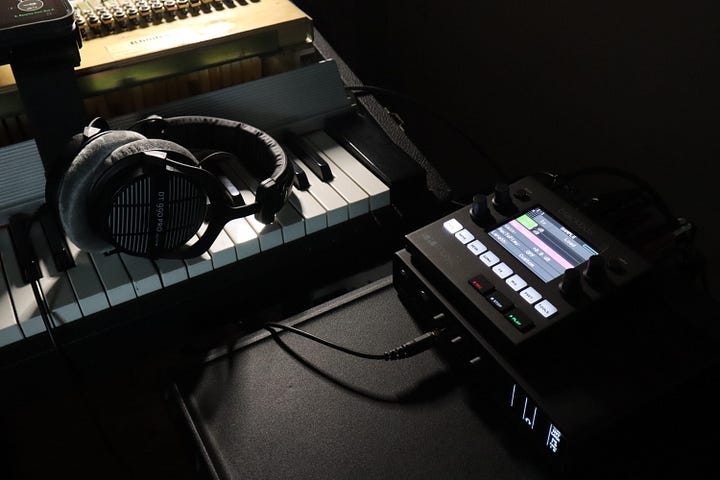
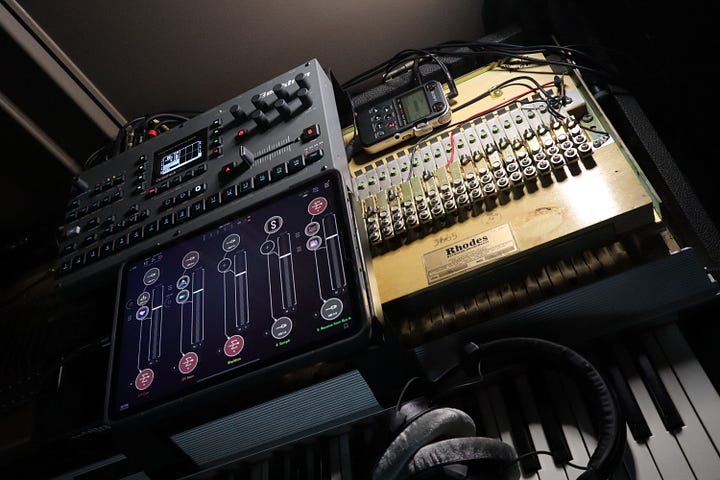
The equipment in use
Octatrack
The beating heart of the setup is my Octatrack sampler. This session uses its 8 tracks set up as such:
Track 1: Thru Machine - processing the live sound of the Rhodes (through a Sansamp DI) on input A with the DJ EQ and Delay effects.
Track 2: Flex Machine - recording Track 1 as desired.
Track 3: Thru Machine - processing live sound of the contact mic (made by Jez Riley French) on input B with DJ EQ and lo-fi effects.
Track 4: Thru Machine - processing live sound from my electret omni mic pair on the Sony PCM-M10 recorder, connected to inputs C and D summed to mono, using DJ EQ and lo-fi effects. These mics are made by a now-defunct Swedish company called Luhd microphones; but they use the same hyper-sensitive and low noise electret capsules found on popular LOM Uši and Clippy mics.
Tracks 5-7: Flex Machines - each recording the main output of the Octatrack and effected with DJ EQ and lofi effects.
Track 8: Master - Compressor and DJ EQ for tone shaping.
The main outs are sent to my MOTU Ultralite Mk5 audio interface, connected to my iPad (explained next). I also have the cue outputs sent there on a separate channel.
I’m not using midi sync in this example, so nothing to report there.
Throughout the video, you’ll notice that I’m using the crossfader quite a bit. I’ve set up Scene 1 on the left to silence the volume of track 1, while scene 9 on the right maxes it out. This way, I can let in Rhodes sound more gradually and manually elongate the attack. This is a nice way to create pads and ambience, and is something I do all the time with ADSR envelopes in software sample libraries.
Another note - many of the bass drones you hear are the result of maxing out the feedback of the delay on Track 1.
I really like that the Octatrack delay doesn’t self-oscillate at maximum: when you want to make an instant drone or wall of sound, you can crank the feedback to maximum and the delay repeats will continue endlessly. This is a nice way to hold on to noises for longer and “freeze” a sound, then sample it into the flex track buffers.
iPad
Of course, iPad is here, too, as a do-it-all utility device: sampling, looping, effects processing, mixing, and recording.
Within AUM there are several channels:
input 3/4 on Motu: receiving audio from the Cue Output of Octatrack. Although I don’t use it on this video, I like having the option to send specific portions of Octatrack sound for processing on the iPad, separate from the main output. On this channel, I’ve added Imaginando FRMS granular synthesizer and K7D delay in case I feel like making granular samples from any specific Octatrack sounds.
Input 5/6 on Motu: receiving audio from the main output of Octatrack. To expand on the sounds from Octatrack further, I have a Fabfilter Pro Q equalizer for tone shaping, which then feeds Loopy Pro (looping), K7D (tape delay), and Blackhole (reverb). I did end up looping one sound in Loopy Pro, and share what that sounds like in isolation below, but for the most part I’m just adjusting delay and reverb for spaciousness.
Here’s the loop I captured in Loopy Pro - it’s a small piece of the sample rate-reduced and bitcrushed sound on Track 5’s flex machine sample:
Inter App Audio (IAA) from Samplr. This channel is doing a lot of the heavy lifting early on to establish the looping drones and altered mechanical noises. The motion recording feature is so crucial for adding movement to static sounds and the ability to record your hand movements really plays into the iPad‘s strength as a gestural controller. I like that all the samples Samplr is playing back here are asynchronous, and they don’t cleanly overlap as they fade in and out over different record times.
Another tip to keep in mind is that the distortion effect (top right) makes a very nice volume boost if, as happened to me in the video, you realize your input source is a little too quiet and you need to quickly gain up a sample in a pinch.
Here are the samples in isolation:
The 1010 Music Blackbox sampler gets its own channel on Motu inputs 7/8. More on that below.
Finally, a master channel with Fabfilter Pro-C2 compressor and Pro-L2 limiter helps tame any spike in volume. This is the channel I recorded when capturing the audio for the video.
Blackbox
Another very important feature of the AUM session is that I have a hardware send on most channels to route audio to outputs 3/4 - each of those leads to the Blackbox’s audio input to capture samples.
I mostly use the Blackbox to add textural noises and hissing sounds (captured from the input jack of the Rhodes and other sounds). A bit of extra flavor to fade in every now and then.
At one point in the video, you’ll notice that I recorded audio routed from Samplr onto a pad of the blackbox, then played it back an octave up. This is very easy to do on blackbox, and the wide range of gain and filter sweeps available lets you blend in sounds gradually without suddenly introducing any obnoxious layers - you can bring it in gently and carefully with volume and filters, feel it out, and make the call as to whether it fits. No harm, no foul.
I love playing live shows with the blackbox because of its tiny size and the ability to play back samples of any length, polyphonically, for rich multi-octave layers. I do this quite often with Hotel Neon to play back critical Kontakt sounds that were used on the albums.
Here’s a good example of what I mean, from an older YouTube video of mine: I recorded a simple middle C piano sample from Lekko piano by Felt Instruments to the blackbox, and then played it back polyphonically as its own synth engine, basically.
^^ And there it is on stage with me in Richmond, VA, last December! A great fit on any noise table. With 16 pads and a great-sounding filter, it’s an easy way to add extra texture and layers to a piece.
Closing thoughts
Like I said up top, I think there were a lot of things I’d do differently if I recorded this twice: I don’t think I did a great job of adding enough movement and interest in the high end, and the middle section’s drone started to sound a little fatiguing to me after a while, as a result. I also thought that the piece didn’t start in a particularly interesting way, and perhaps I could’ve captured more interesting sounds with the mics. Oh well.
I really like what someone shared with me on the 12k discord server after I shared this video there, and expressed some regret about these things:
yeah but feeling what you wanted to reach out and do but couldn't is the way we can evolve the system to try and make it so that next time you *can* do what you wanted to in the moment
That’s exactly right. I think I’m close to figuring out a better way to use this gear more effectively because of this jam.
Thanks to this trial run, I’m looking forward to recording my Rhodes some more with a fresh perspective since the last time in 2018, and knowing what I know now.
One more thing: I have some recommendations for those who would like to experiment with the Rhodes sound, but can’t justify the real thing.
As much as I love my Rhodes, I will admit that I rarely use it when I want a Rhodes sound on a recording. It’s way easier to load up and use as a software instrument.
Here are my 2 go-to, “first-things-I-always-reach-for electric piano sounds:
Soniccouture EP73 Deconstructed: favorite on desktop/Kontakt. This may not be the most dead accurate model of a perfect Rhodes, but it is a perfect model of a characterful one, and was recorded in exactly the way I use my own Rhodes with the lid off: contact mics connected and all. I love how “vibey” this particular 1976 Rhodes sounds, and it has so many of the same quirks and hiccups that my own piano does. It’s eerie how much it sounds like my own model. Flexibility to dial in long attack times, mix between line out/amplifier/contact mic sounds, and very low strain on CPU make this a no-brainer, in my opinion. https://www.soniccouture.com/en/products/24-vintage/g36-ep73-deconstructed/
Apesoft Electric Vintage: favorite on iOS. I’ve written about this instrument before, and I think it’s a true hidden gem of an app for any iOS musician. The piano sounds great right away with no effort tweaking the details, but there are so many ways to adjust the sound under the hood that you can get in very experimental territory very quickly. Full ADSR control is again a very quick way to generate beautiful pads with long attack times, and the “slice” effect is a genuinely creative glitchy delay that sounds excellent. https://apps.apple.com/us/app/electric-vintage/id1518380765
More music, writing, and videos are sure to come soon.
Thanks for reading!



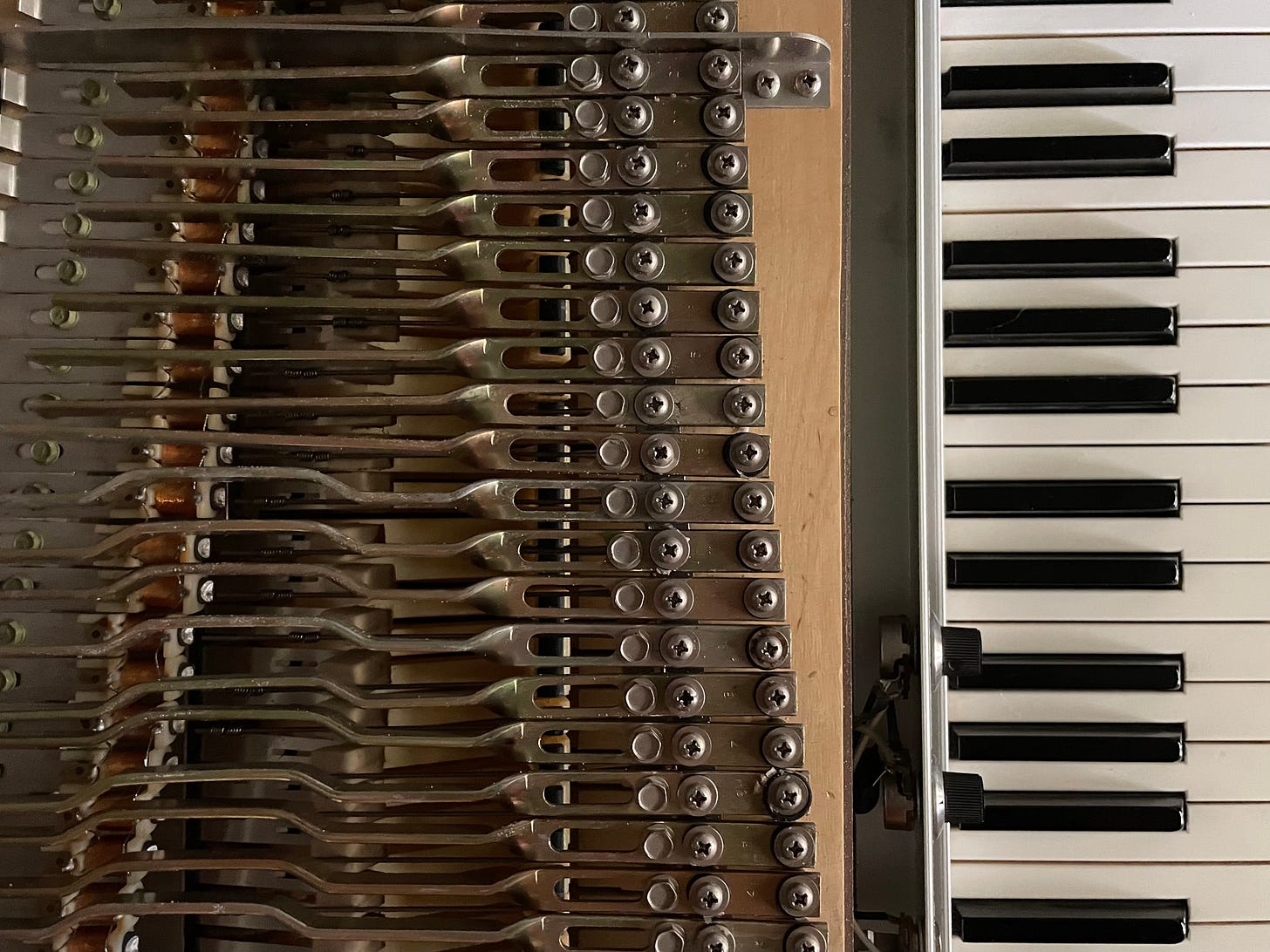
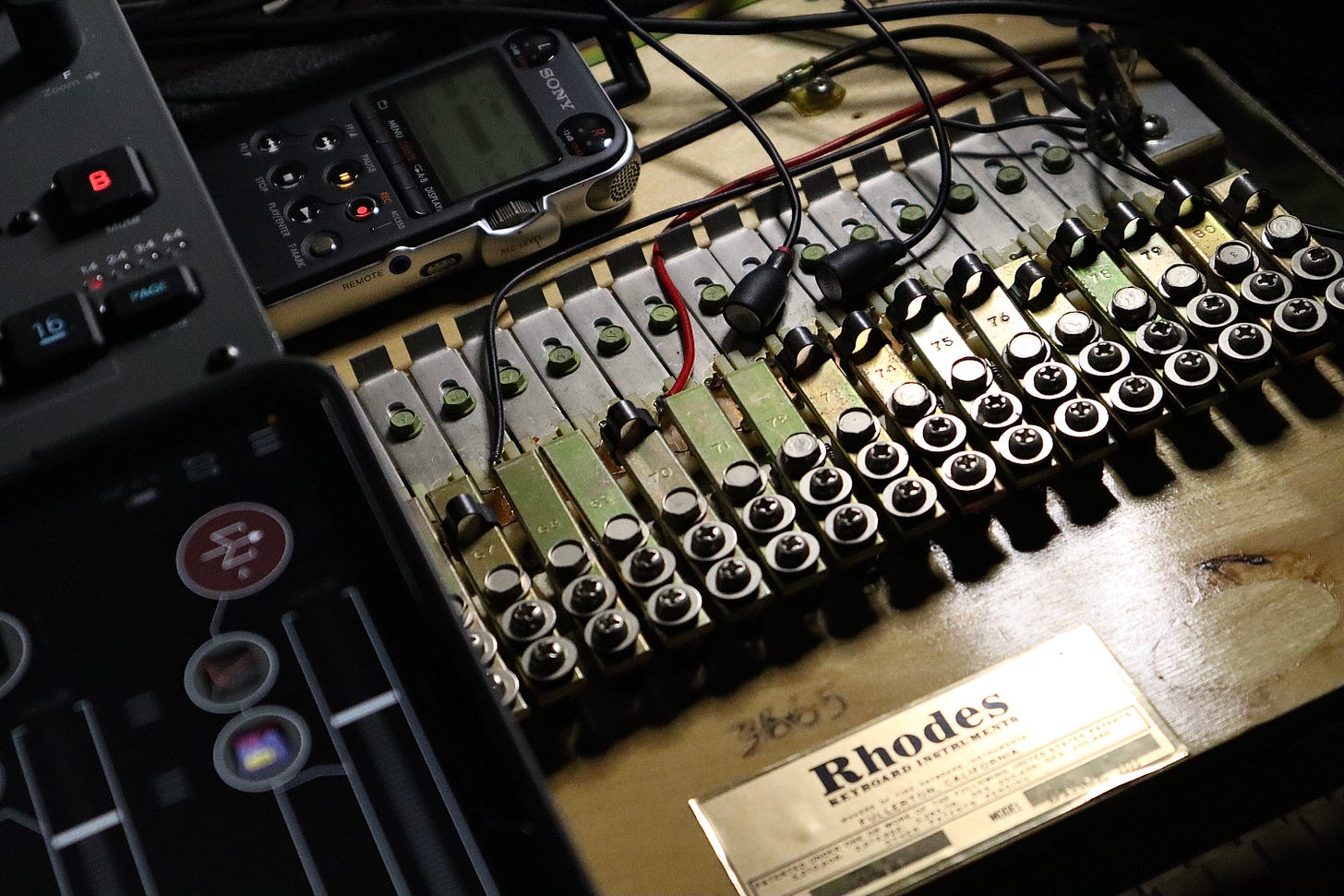
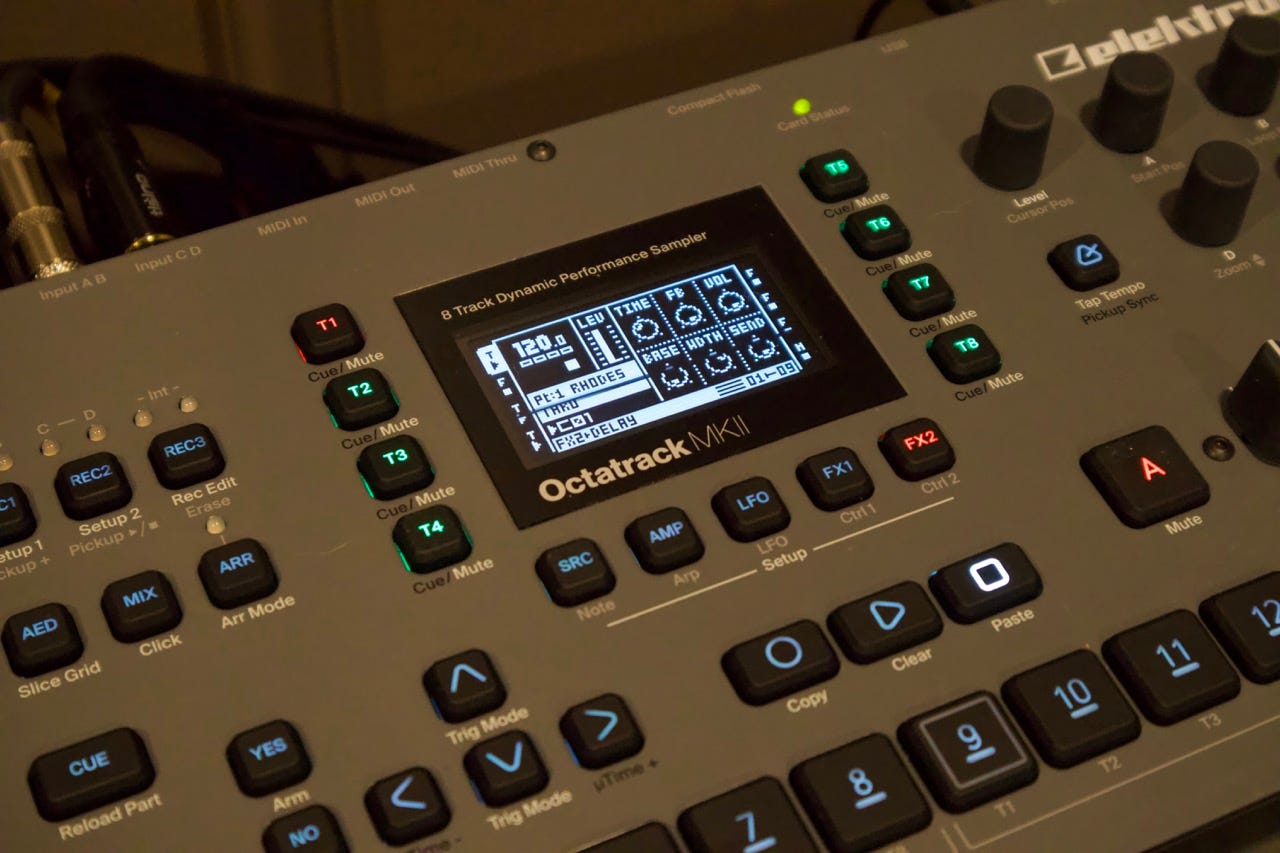
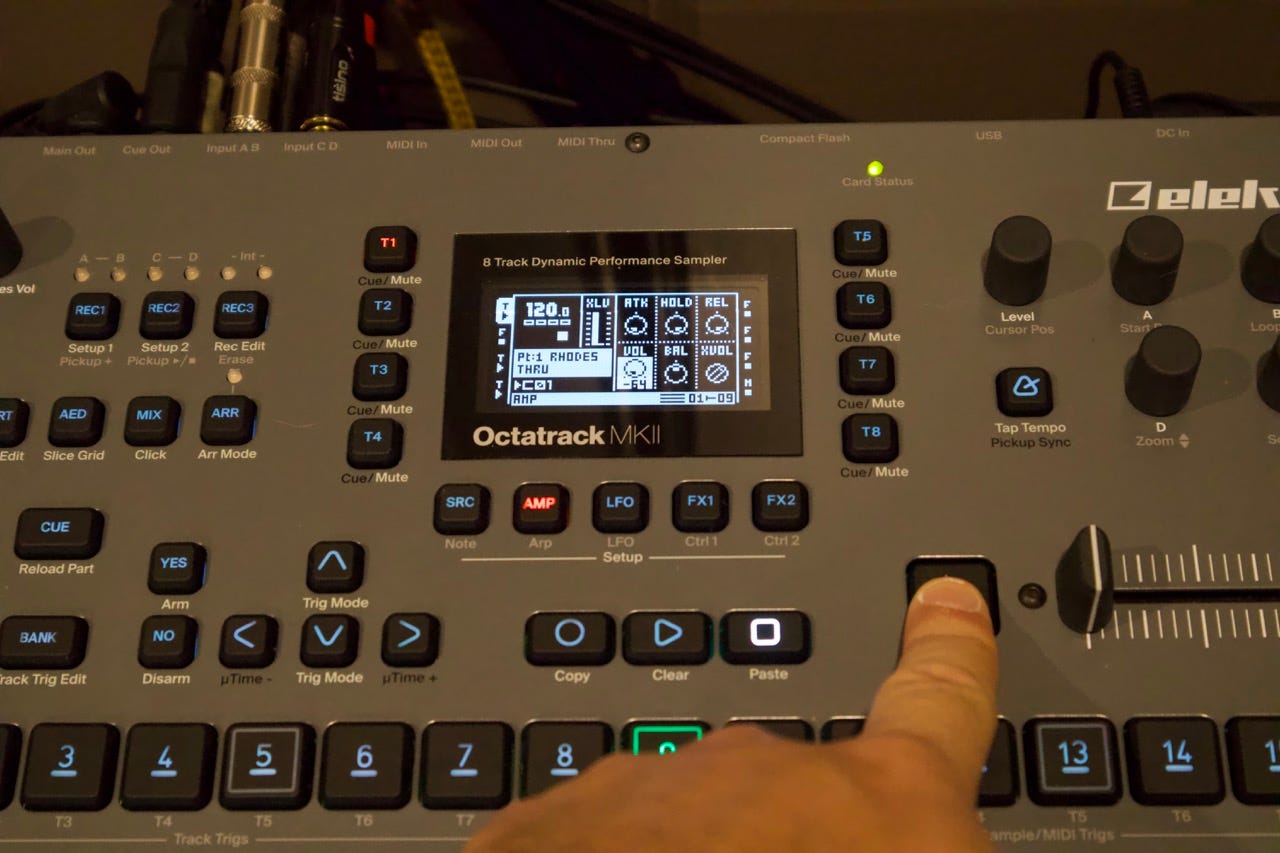
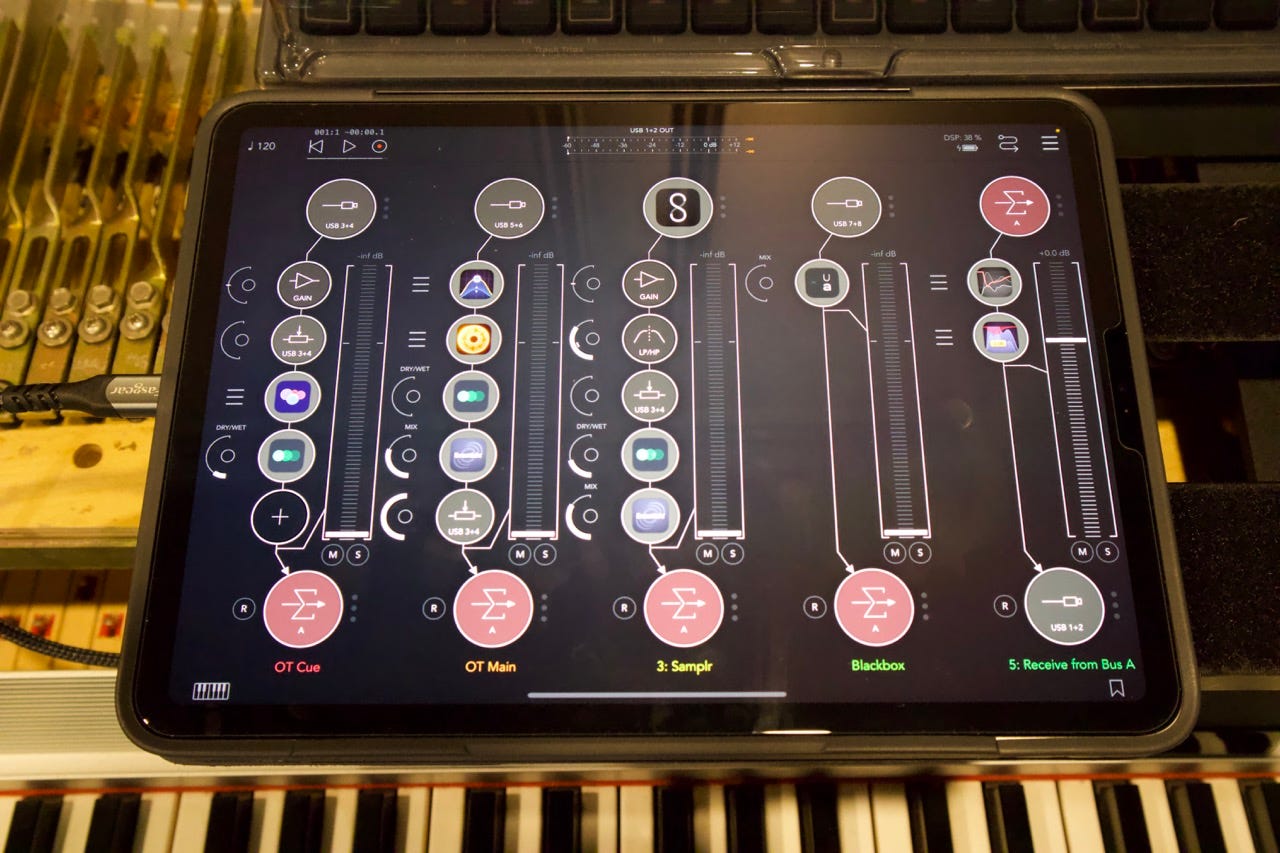
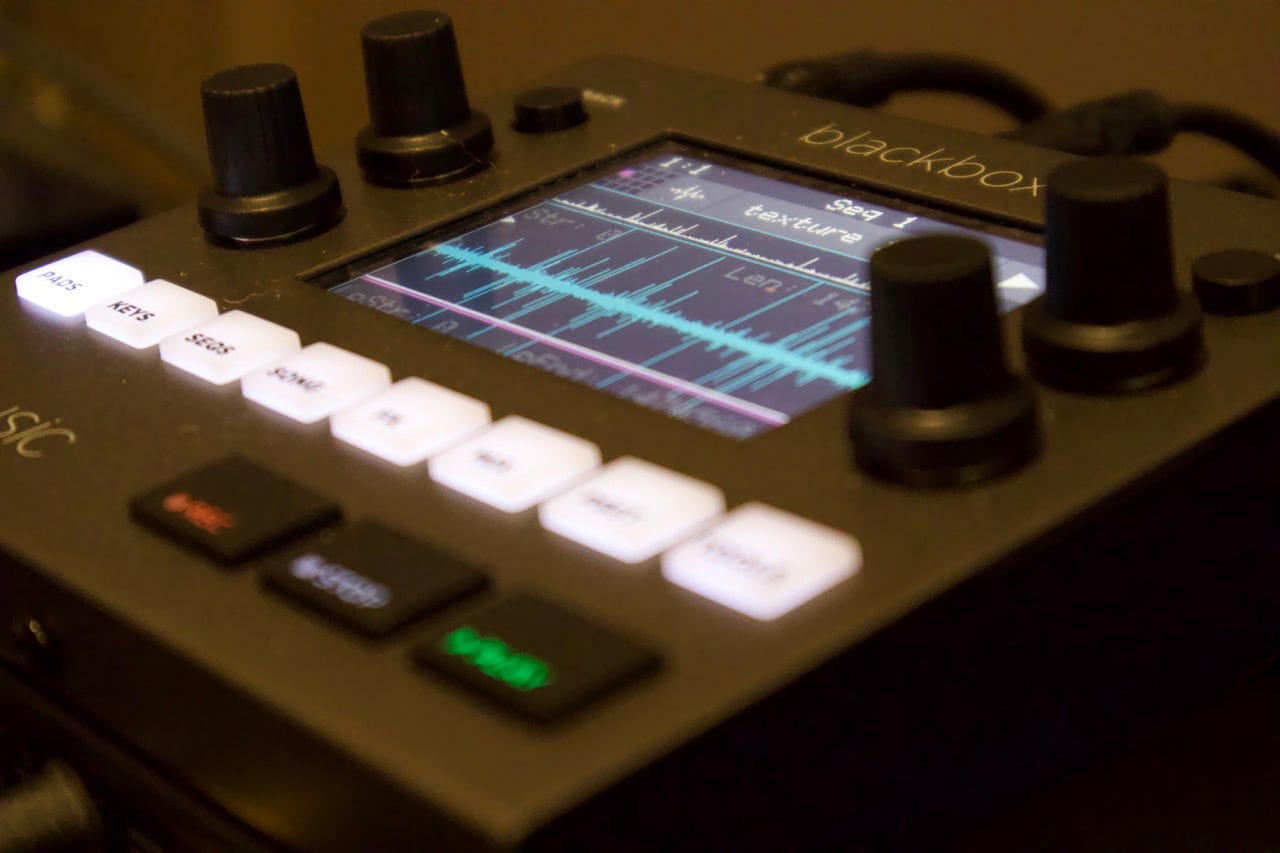
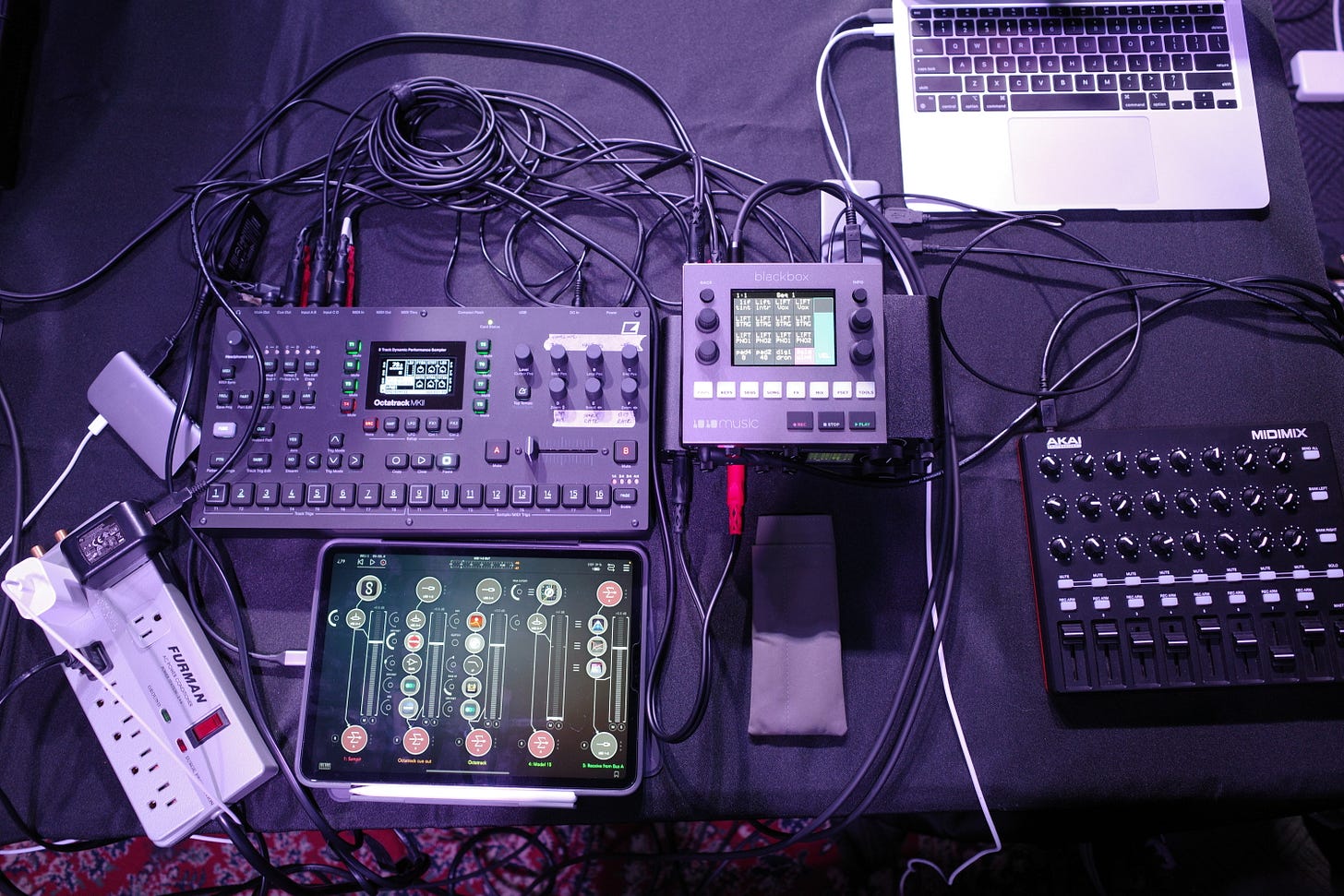
A real hit of inspiration, thank you for sharing this Andrew. What a wonderful studio diary, I really liked reading everything that goes into the work you make. Beautiful stuff!
Man, always good stuff from you, thanks!
Though it is certainly stylized, my fav Rhodes plug-in right now is Teletone’s Vespertone.
I pay homage to the ur-instrument of lofi in a post from a few months ago: https://www.polyestercity.com/p/episode-002-the-ruins-of-holyrood